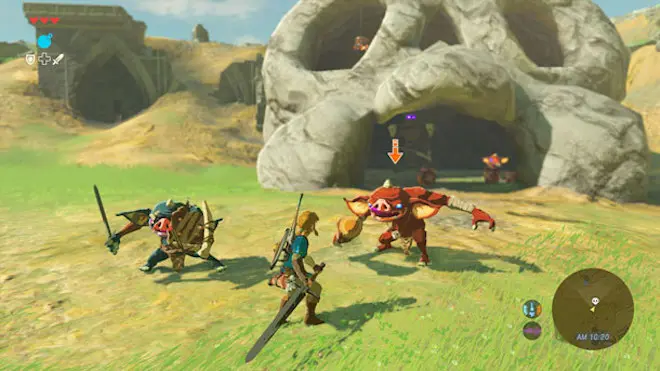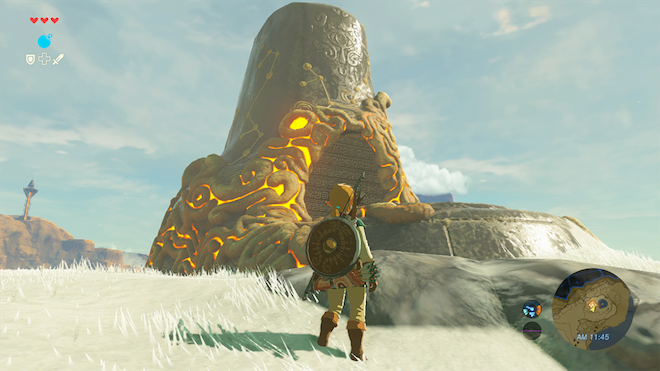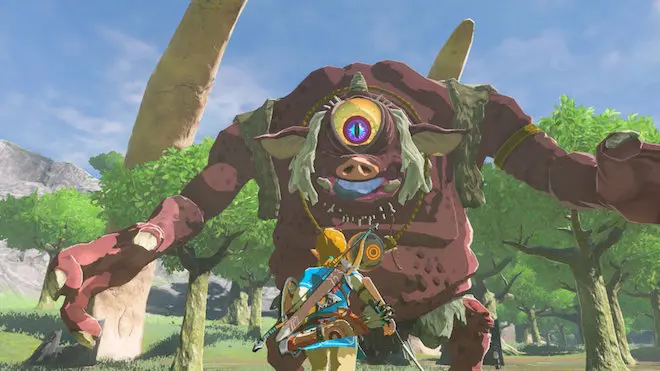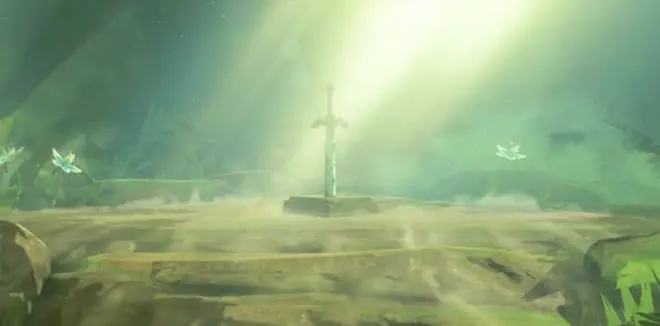The Legend of Zelda has always been a game about exploring. Since the very first game, which opened with players taking control of a young elven-like protagonist and setting off in a huge world filled with dangers and dungeons, and a big blue pig with delusions of grandeur, the franchise has been beloved by fans and critics alike. But apart from that very first game, that true sense of exploration and wonder has been missing from the series. Sure, A Link to the Past was an epic game with tons of hidden secrets, and Ocarina of Time was even bigger, and allowed for some major exploration, both of those games took players on a very set path (even if you weren’t aware of it), and things had to be done in a set order to finish the game.
In The Legend of Zelda: Breath of the Wild for the Wii U and Nintendo Switch, Nintendo has gone back to what made the Zelda series so special in the first place, as they essentially drop players into a world devastated by an evil force, and with very little nudging, allows the player to experience the land of Hyrule however they see fit. Heck, even the game’s story is optional.
In Breath of the Wild, players once again control Link, the legendary Hero of Hyrule, who awakens 100 years after Calamity Ganon defeated King Rhoam, Princess Zelda and her champions, and Link himself, Zelda’s appointed knight. Link was put into a restoration chamber and there he rested for a century until he was ready to emerge and set off to save Zelda and defeat Ganon once and for all.
Link wakes up to find an old bearded man, mirroring the events of the very first game, who doesn’t just give him a sword, because it’s dangerous to go alone. The old man here gets Link started on his journey by introducing him to some of the new game mechanics in BotW. This “tutorial” portion of the game is rather short, and sets Link up with the Rune magic that he will need to go out into the wider world to explore, hunt, cook, buy a homestead, make new friends, and eventually, if he chooses to, save Hyrule. It is a bold new direction for a legendary game series that some have argued had grown stale in recent titles.
Once out in the world, Link’s journey is completely up to the player. There are guiding characters, like Impa and the Sheikahs, and the four races of Hyrule are still here, each with their own issues that Link can choose to take part in, but how and when they are visited is completely up to the player and what cardinal direction they choose to take after acquiring the glider, which is the reward for completing the tutorial section. The glider opens up the greater world, as Link can essentially fly/glide from great heights.
Link is armed with a tablet-like device called the Sheikah Stone which activates and unlocks temples and towers, and even serves as a camera to take pictures of, well, anything he sees fit. Taking pictures of enemies and items works to fill a Hyrule Compendium which is a comprehensive record of all things Hyrule. The Sheikah Stone contains images of the memories that Link has to “remember,” which marks how the story is told in Breath of the Wild. This is a unique way to handle the narrative, and again allows the player to focus on exploration instead of moving a story along.
I have never felt more open and free in a Zelda game. The list of things you can do here is staggering. On top of hunting and cooking, and of eventually buying a renovating a house, Link can catch and train wild horses, hunt mythical dragons (over and over for loot drops), participate in various races around the world, including a shield sledding course, which is exactly what you think it is, and so much more. The biggest, and best addition to all of this is Link’s ability to climb. More than a gimmick, climbing opens up the world like never before, and the mechanic to do this is so free that anything can be climbed at any time (save for when it rains, but I will get to that), and estimating a climb distance based on the amount of stamina Link has is very important, because if Link runs out of stamina, he falls and that is bad. Very bad.
There are over 100 temples to find and conquer, most possessing some type of puzzle element, some requiring the defeat of a powerful Guardian. Solving these temples awards Link with a spirit orb, which can be traded for heart containers and stamina vessels. These temples take the place of traditional dungeons, though there are still four epic “dungeons” to conquer as well.
In addition, there are over 900 (NINE HUNDRED!) Korok children hidden throughout the land. These Koroks offer Link a seed that, when collected, he can trade in for bigger pockets to hold more weapons, and this is key, as, for the first time, Link doesn’t have a dedicated weapon set. He collects weapons of various strength and power as he goes, and these weapons break, some very easily, so going through weapons and constantly refreshing them is paramount to surviving. Even the Master Sword, which Link can eventually find, can lose its power and will have to go through a 10 minute cool down before it can be used again. Weapon, bow, and shield juggling becomes an issue early and is always on the mind of the player as they explore.
There is a story in The Legend of Zelda: Breath of the Wild, and its pretty epic in and of itself. A great calamity, known as Ganon, hits the land every 10,000 years, and the ruling family of Hyrule is always there to stop it, with the help of a “hero.” The last time, the Hylians built technologically advanced Guardians, tall towers for lookouts, and four Divine Beasts, each piloted by a champion, one for each race, to stop Ganon and it worked. But the embodiment of evil and malice had other plans, and 100 years ago, he was able to take control of the Guardians and the Divine Beasts. Ganon killed the four champions and mortally wounded Zelda’s knight, Link. He then dragged Zelda into a conflict that essentially locked her up as she tried to hold his dark power at bay until Link could awaken and save her.
Link’s task is to reactivate the four Divine Beasts, unlock all the towers, find the Master Sword, and then venture into Hyrule Castle and face off with Calamity Ganon one final time.
The land of Hyrule in The Legend of Zelda: Breath of the Wild is the largest ever, by far. It is reportedly 10 times larger than the world of Skyrim. Let that sink in for a second. Every region is present, including the hot, lava-flowing volcano of Death Mountain, the snowy peaks of the Hebra Mountains, to the grassy plains of Hyrule Field, to the mired swamps of Mido (and many others). There are Lost Woods and coastal villages. Tropical and desert locales too. And Link must be prepared before he ventures into them, either with potions to heat/cool him, or by changing his outfits, of which there are many. There’s a reason that is took me over a month to review this game. Because for the last 81 hours of my gaming life, I’ve completely lived a second existence in Hyrule. And I’m okay with that.
Weather elements and day/night cycles also play a huge role here. When it rains, it’s too slick for Link to climb. Thunderstorms can cause Link to be struck by lightning if he has any metal weapons of shields equipped (which sucks!). And night time brings out skeletal versions of enemies. Probably the worst thing in the game is the dreaded Blood Moon, which happens once a month in game time, and when it does, every killed enemy returns to life, and they are stronger than before. Essentially, this is the game’s way of leveling up the enemies as Link himself gets stronger (with more hearts and better weapons, in theory, depending how you are playing). Blood moons can cause serious havoc is they occur at the worst time, and it will happen. Some gamers have even reported a Blood Moon happening during the final battle, which is awful. I myself, during my final battle with Ganon, saw the Blood Moon crest the horizon, and luckily I was able to end him before it reached its zenith or I would have been in trouble.
Instead of the classic dungeon bosses (there still are four bosses, but they are more representations of Ganon himself, and they are pretty straight forward fights) Hyrule is littered with very powerful enemies that Link can choose to fight, including the one-eyed Hinox, the desert dwelling sand worm Molduga, and more. Classic enemies from Zelda lore also return, including Keese, Stalfos, and Octoroks, and even the Lynel, which were the centaur-like creatures from the first game. Here, they are incredibly imposing and ridiculously powerful. In fact, I’ve defeated end-game Ganon twice now, and have still yet to take out a Lynel. It’s not worth the cost on weapons and potions and food to do so when the battles can be avoided. I may never get the joy of killing a Lynel, but I’ve taken out ancient dragons and the embodiment of pure evil, so it’s a fair trade.
Graphically, The Legend of Zelda: Breath of the Wild doesn’t try to push the boundaries of realism, and instead uses a cell-shaded design that mixes Skyward Sword with The Wind Waker and the results work out wonderfully. The soundtrack in Breath of the Wild is subdued, with more piano and less bombastic horns and strings. The classic songs are still there, some rearranged to fit the overall score (especially in Hyrule Castle), and the new song that plays when Link recovers a memory might be the best piece of music in the whole game. Music has always played a huge role in the Zelda mythos, and that tradition continues here.
The Legend of Zelda: Breath of the Wild has some incredible amiibo support. Not only are there five BotW-specific amiibos, but any Legend of Zelda amiibo figure will work, and they all give Link much needed supplies, rupees, weapons, and very rare items, like classic Zelda weapons and armor pieces (green tunic!). The Twilight Princess amiibo even gives Link wolf-link to serve as a companion, and depending on how the amiibo was used in the Twilight Princess HD game, can have up to 20 hearts, making it a strong ally who will attack any enemy that tries to harm Link. One amiibo even unlocks Epona from Ocarina of Time. This is the best usage of amiibos in any Nintendo game yet.
There is so much to do in The Legend of Zelda: Breath of the Wild that I could go on and on trying to cover it all, but it would be best for gamers to just jump in and start playing. That’s how Nintendo wants the game to be played and they have made every possible accommodation to the player to do this. In fact, Breath of the Wild is so big and open and unique in how it is presented, I’m not too sure where Nintendo can go from here in the Zelda franchise. This game is the culmination of all of the games that have come before it, and is still the perfect call back to the wonder and exploration of the very first game. It was a lofty goal to try and accomplish, and Nintendo has done just that. At this point, its cliche to call this the best Zelda game ever, but it is. Without argument. This is the game that video game fans have waited for and dreamed about ever since they met that strange old man in the cave and took his sword back in 1986-87. Nearly everything in The Legend of Zelda: Breath of the Wild works, and for the rare times that something doesn’t work, it is quickly forgotten, as there is always something else to discover that rights any wrongs.
I make it no secret that I love The Legend of Zelda. It is a game that changed my life, and you would not be reading these words without it. There are chapters of my existence that are marked with Zelda releases, so, just like good music is can sometimes be referred to as a “soundtrack to a life,” Zelda is the game series of my life. The Legend of Zelda: Breath of the Wild has taken that love for the series and expounded on it in ways I never thought possible. This is the perfect game, and just like the first game in the series, every game that comes out now will be compared to it. I don’t type these words lightly. And it is certainly not hyperbole. The Legend of Zelda: Breath of the Wild is one of the best games I have ever played, and I hope this review explains why.
The Legend of Zelda: Breath of the Wild is available now for the Nintendo Switch and Nintendo Wii U. This review is based off a copy of the game purchased at retail.













